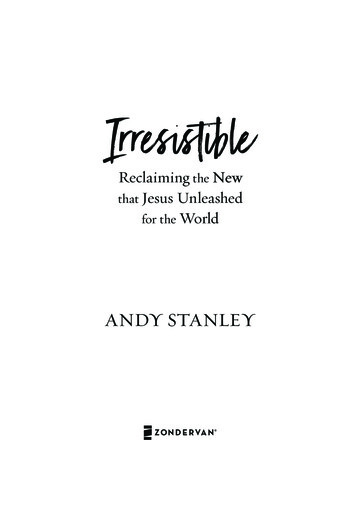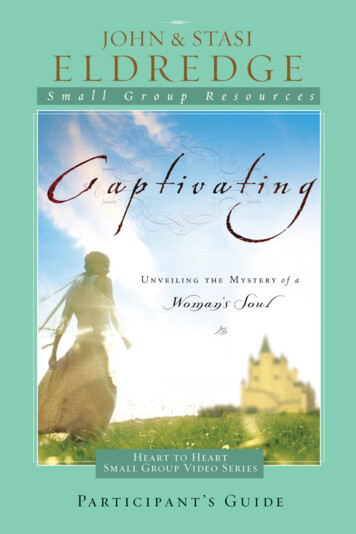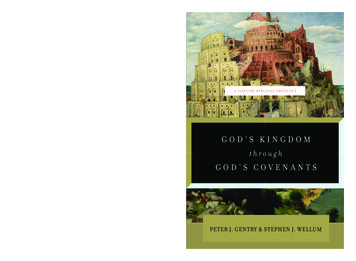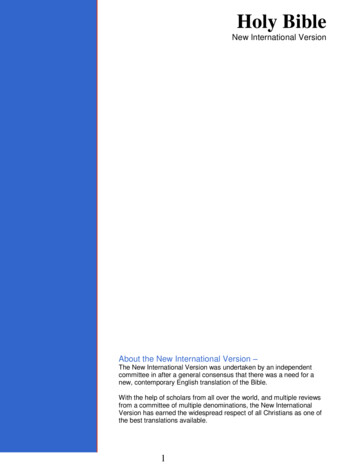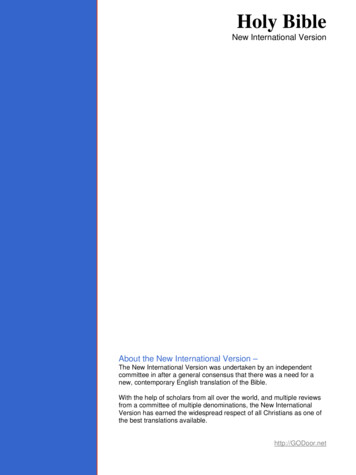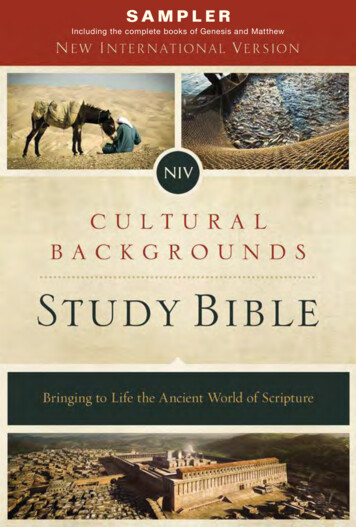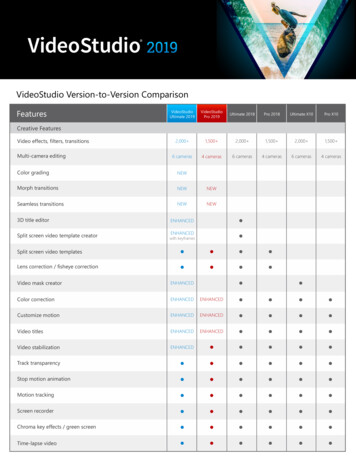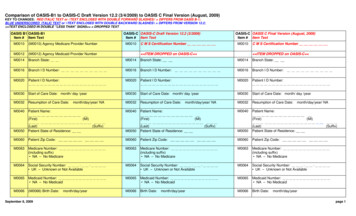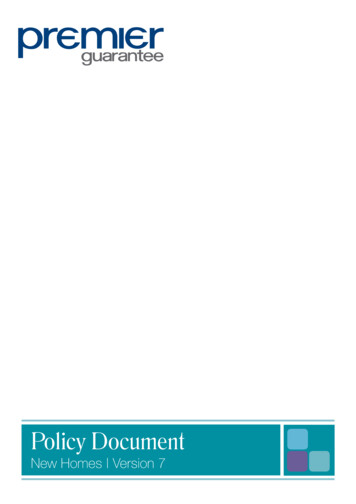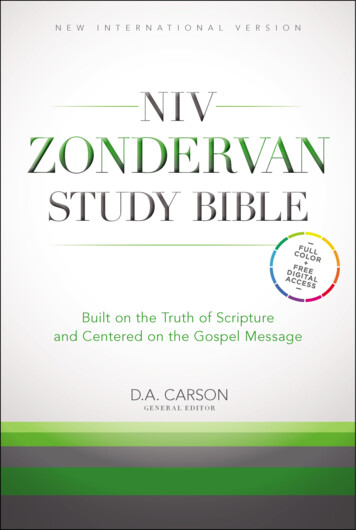
Transcription
N E WI N T E R N A T I O N A LV E R S I O NNIVZONDERVANSTUDY BIBLE
N E WI N T E R N A T I O N A LV E R S I O NNIVZONDERVANSTUDY BIBLEBuilt on the Truth of Scriptureand Centered on the Gospel MessageD. A. CARSONGE N ER A L EDI TOR
NIV Zondervan Study BibleCopyright 2015 by ZondervanAll rights reservedThe Holy Bible, New International Version , NIV Copyright 1973, 1978, 1984, 2011 by Biblica, Inc. Used by Permission. All rights reserved worldwide.Published by ZondervanGrand Rapids, Michigan, USAwww.zondervan.com“New International Version” and “NIV” are registered trademarks of Biblica, Inc. Used by permission.Notes, Book Introductions, Articles, Illustrations, Indexes copyright 2015 by Zondervan; The NIV Concordance copyright 1982, 1984, 2011 by Zondervan; The NIV Side Column Reference System copyright 1984 by Zondervan; Maps byInternational Mapping. Copyright 2009, 2011 by Zondervan. All rights reserved. Charts copyright by Zondervan unlessotherwise noted.Parts of the book of Ezekiel have been adapted from the NIV Study Bible, copyright 1985, 2011 by Zondervan. All rightsreserved.Library of Congress Catalog Card Number 2015932390The NIV text may be quoted in any form (written, visual, electronic or audio), up to and inclusive of five hundred (500)verses without the express written permission of the publisher, providing the verses quoted do not amount to a completebook of the Bible nor do the verses quoted account for twenty-five percent (25%) or more of the total text of the work inwhich they are quoted.Notice of copyright must appear on the title or copyright page as follows:Scripture quotations taken from The Holy Bible, New International Version , NIV .Copyright 1973, 1978, 1984, 2011 by Biblica, Inc. Used by permission. All rights reserved worldwide.The “NIV” and “New International Version” are trademarks registered in the United States Patent and Trademark Office byBiblica, Inc. When quotations from the NIV text are used by a local church in non-saleable media such as church bulletins, orders ofservice, posters, overhead transparencies, or similar materials, a complete copyright notice is not required, but the initials(NIV ) must appear at the end of each quotation.Any commentary or other biblical reference work produced for commercial sale, that uses the NIV text must obtain writtenpermission for use of the NIV text.Permission requests for commercial use within the USA and Canada that exceeds the above guidelines must be directed toand approved in writing by Zondervan, 3900 Sparks Drive SE, Grand Rapids, MI 49546, USA. www.Zondervan.comPermission requests for commercial use within the UK, EU and EFTA that exceeds the above guidelines must be directedto and approved in writing by Hodder & Stoughton Limited, 338 Euston Road, London NW1 3BH, United Kingdom. www.Hodder.co.ukPermission requests for non-commercial use that exceeds the above guidelines must be directed to and approved in writingby Biblica US, Inc., 1820 Jet Stream Drive, Colorado Springs, CO 80921, USA. www.Biblica.comAny Internet addresses (websites, blogs, etc.) and telephone numbers in this Bible are offered as a resource. They are notintended in any way to be or imply an endorsement by Zondervan, nor does Zondervan vouch for the content of these sitesand numbers for the life of the Bible.All rights reserved.Printed in China N12071215 16 17 18 19 20 21 22 23 24 25 /CTC/ 15 14 13 12 11 10 9 8 7 6 5 4 3 2 1A portion of the purchase price of your NIV Bible is provided to Biblica so together we support the mission of Transforminglives through God’s Word.Biblica provides God’s Word to people through translation, publishing and Bible engagement in Africa,Asia Pacific, Europe, Latin America, Middle East, and North America. Through its worldwide reach, Biblicaengages people with God’s Word so that their lives are transformed through a relationship with JesusChrist.
QUICK START GUIDEWH AT I S T H I S S T U DY BI BL E ?The NIV Zondervan Study Bible is an all new study Bible built on the truth of Scripture and centering on “biblical theology” — the ways in which many important themes work their way through Scripture and come to a focus in JesusChrist. It’s a comprehensive combination of newly crafted study notes, articles, book introductions and study tools.WH AT D O T H E FE AT UR E S OF T HI S ST UDY B I BL E OF F E R ME ?Book introductions: When was this book written? Why was it written? How does the book fit with the rest ofScripture? What is in it? Nearly every book of the Bible begins with an introduction that offers helpful informationabout the book. The book introductions answer questions you may have about the book, and each book introductionprovides an outline of the book.#1 Palestine (OldNSETRNEYS 50%DMgTo EBeershebaRive rGILEADMSea ofGalileeMahanaimDeadSeaDinah and the34 ➁EdreiPenielJorda nShechemAiEphrath(Bethlehem)yptKiriath Arba(Hebron)00Shechemites40 km.40 mi.r ra nEAHaTo heba0 10 km.0DamascusBethelJerusalemHebronGaza ➃AphekGerarediterraneanN AME AN D PU R PO S EThe title, Genesis, means “beginning.” It is the title of the book in the Septuagint (the pre-Christian Greek translationof the OT). This aptly describes a book that outlines the creation of the world and humanity (chs. 1 – 2) and goes onto describe the beginning of sin (ch. 3), the new creation (ch. 9), God’s plan for blessing the world (12:1 – 3), andhow that plan begins with the family of Abraham (chs. 12 – 50). The Jewish title of the book, Bĕrēʾšît, is taken fromthe first word in the Hebrew text: “In the beginning.” It also emphasizes that the book is concerned with origins.Genesis is the first of the five books of the Pentateuch (see Introduction to the Pentateuch, p. 9). Unlike theother books of the Torah, Genesis contains almost all narrative and few legal commands. Its purpose is to trace thebeginnings of the world, humanity, and sin and to draw a line across human history that identifies God’s work withAbraham and his family. Thus, the book provides the necessary background for the divinely chosen origins of God’speople Israel and for their situation in Egypt at the beginning of Exodus. It also introduces God as Creator, Judge,and Redeemer. It describes the fall into sin and looks forward to how God will resolve his separation from the peoplehe loved and created.B AC K G R O U N D AN D AU T H ORExod 17:14 and Deut 31:9,24 attest to the composition of much of the first five books by Moses. Moses’ composition ofGenesis was assumed until the advent of critical studies of the Bible that questioned its validity. Since then, scholarshave argued for dividing Genesis into separate parts and dating them to different times. Multiple authors wouldthen have written the book, some of them centuries after the time of Moses. However, it is now clear that many ofthe events of Genesis, when compared to examples of ancient Near Eastern texts, date to the period before Moses, ca.2200 – 1500 BC, and not later.1. The creation account of Genesis has been compared with the Babylonian Enuma Elish, a story about howthe god Marduk defeats a monster and creates the other gods from her body. Archaeologists discovered this story inthe library of an Assyrian king from the seventh century BC. But a closer parallel to Gen 1 – 11, with stories of thecreation of humankind followed by a flood, with a family and animals surviving on an ark, appears much earlier inthe eighteenth-century BC Atrah̯ asis Epic.2. Many texts, including the Atrah̯ asis Epic, mention a worldwide flood. Most famous is the Gilgamesh Epic. Theearliest text we have dates from the eighteenth century BC. It was copied in many places and times in the ancient NearEast. Like Atrah̯ asis, Gilgamesh has parallels with the details of Gen 6 – 9. A god decides to preserve a family, peopleconstruct a ship and bring animals into an ark and close the door, and the flood destroys everything outside the ark.These similarities should not blind us to the teaching of Gen 6 – 9 that God used the flood to judge the world andsave righteous Noah and all on the ark in order to make a covenant with them upon disembarking (8:20 — 9:17).3. Personal names can also attest to an early date for Genesis. Some of the names in chs. 1 – 11 occur only in theedSeaCAOrontes R.R i veINTRODUCTION TOBalikh RiverratesEblaPenielSukkothShechemILHarranrDothanG ➀Jo rd a n R .iterraneanNASeANaCarchemishAleppo34:7 83 66.6%P A D D ANA R A MGENESISGenesismap 01 31 jacobIbJACOB’S JOUmap 01 31 jacoe)phStudy notes: What is the Biblesaying here? God’s Word was written down many years ago by different authors in different settings.The study notes at the bottom ofeach page explain or give background on words, phrases, and theflow of the argument to aid you inbetter understanding what God issaying in his Word. Each note wasthoughtfully crafted to guide you inmore clearly comprehending theWord of God.#2 Levant (OldPalestinEuCross reference system: Wheredoes this word or term appear inother parts of the Bible? A crossreference system enables you tosearch the Scriptures for terms,ideas, and themes that reappear invarious books.Galilee)10 mi. The Euphrates-Bali➀tion as he fled from kh River basin was Jacob’s destinahis maternal uncle Esau, ultimately reaching the home (Laban) near Harran.of Jacob’s lengthy sojourn➁ended in a disputeMAP NOTE:andIn additionanotheto changingwith Labanr flight—Sukkoth spelling,thisI’ve timeupdated “TobackHarran”tolikely took him towardCanaan. His routespelling.Edrei before reachin Aleppo, then to Damascus andg Peniel on theJabbok River. He and his depend➂Gilead before their ents reached the hill countryofcaravan was overtakcovenant at Mizpahen by Laban. Thelater used as a borderwas celebrated on one of the hillsIsraelite territories. station between Aramean and Jacob lingered at➃ceeded to Sheche Sukkoth, entered Canaan andprom, where he erectedan altar to the Lord.Now Dinah, c thedaughter Leah had2borne to Jacob, wentWhen Shechem sonout to visit the womenof Hamor the Hiher. 3His heart wasof the land.drawn to Dinah daugh vite, the ruler of that area, saw her,he took her and rapedto her. 4And Shechemter of Jacob; he lovedsaid to his father5Hamor, “Get me this the young woman and spoke tenderlyWhen Jacob heardgirl as my wife.”that his daughterlivestock; so he didDinah had beendenothfiled,inghisaboutsons were in the6it until they cameThen Shechem’sfields with hishome.father Hamor wentin from the fieldsout to talk with Ja d 7as soon as they heardcob. Meanwhile,Jacob’s sons hadwhatShechem had donecomean outrageous thing a had happened. They were shocked andin Israel e by sleepshould not be done. fing with Jacob’s daugh furious, becauseter — a thing thata7 Or against34:1 c Ge 30:2134:6 d Jdg 14:2‑534:7 e Dt 22:21;Jdg 20:6; 2Sa 13:12Jos 7:15f34:1 – 31 Dinahand thethreatens to underm Shechemites. Shechem’s treatment of Dinahine Jacob’s safecumcision was meantreturn to Canaanactions towardDinah are repreheto be a source of. Shechem’sblessing bynsible. When herAbraham. The punishmwhat was done,brothers find outthey are rightfullent (killing the Shechem connecting others toy enraged.(Shechem’s rapeamends by marryinites) exceeds theof Dinah).crimeg Dinah, but Jacob’s Shechem seeks to make34:2 ruler of thatDeceptively, theysons will not bearea. Hamor waspersuade the menplacated.an influential person.within the communof Shechem toBefore the menHis standingity may well havebe circumcised.of the town haveinfluenced his sonfully recovered,ior and Shechemall the men of ShechemShechem’s behav‑Simeon’ssubsequand Levi killent expectation that. Jacob condemShechem to marrythat it will endangens his sons’ behavioHamor could arrangeDinah. took herr the future of hisr, fearingforandDinah,rapedfamily in Canaanand one result washer. Shechem violated. Ironically, cir‑that she was now34:5 – 7 Jacob andineligible for a properhis sons react differenmarriage.tly: Jacob is slowto act when9780310438339780310438335 int 01a gen exod NIV ZSB SIXTH PROOFS.indd 175 int 01a genexod NIV ZS2/27/15 9:08 AMB SIXTH PROOFS.indd 832/27/15 9:09AMMaps, charts, illustrations, photos: Where did this happen? What else was going on during this time? The easyto-use maps and charts will shed light on the Bible, its places, and its times. Illustrations and photos provideimages that will enrich your experience with God’s Word and give you rich insight to aid your study, for example, bydemonstrating or illustrating the many events in the Bible that are anchored in ancient history.Articles: What does the Bible say about . . . ? At the end of the Bible is a library of biblical-theological articles covering topics such as “The Bible and Theology,” “Law,” “The Gospel,” and “Justice.” Their purpose is to help you tracemajor biblical themes throughout the canon.Concordance: A concordance to the New International Version text is located at the back of the Bible. It will helpyou find the location of words or phrases that are found in the Scripture text.“All Scripture is God-breathed and is useful for teaching, rebuking, correcting and training in righteousness, so that the servant of God may be thoroughly equipped for every good work” (2 Timothy 3:16 – 17).
TABLE OF CONTENTSQuick Start Guide, vT HE O LD T ESTA MEN TTable of Contents:Maps, ixCharts, xiIllustrations, xiiiArticles, xivIntroduction to the OT, 3Introduction to Esther, 879Esther . . . . . . . . . . . . . . . . 883Introduction to the Pentateuch, 9Introduction to the Wisdomand Lyrical Books, 895Introduction to Genesis, 17Genesis . . . . . . . . . . . . . . . . 25Introduction to Job, 901Job . . . . . . . . . . . . . . . . . . . 905Abbreviations andTransliterations, xvIntroduction to Exodus, 113Exodus . . . . . . . . . . . . . . . . 118Introduction to Psalms, 968Psalms . . . . . . . . . . . . . . . . 977Acknowledgments, xviIntroduction to Leviticus, 189Leviticus . . . . . . . . . . . .
The NIV Zondervan Study Bible is an all new study Bible built on the truth of Scripture and centering on “biblical the - ology” — the ways in which many important themes work their way through Scripture and come to a focus in Jesus Christ. It’s a comprehensive combination of newly crafted study notes, articles, book introductions and .
